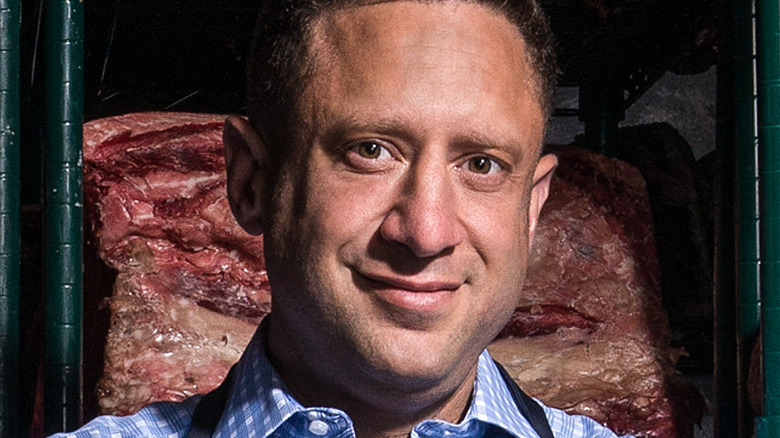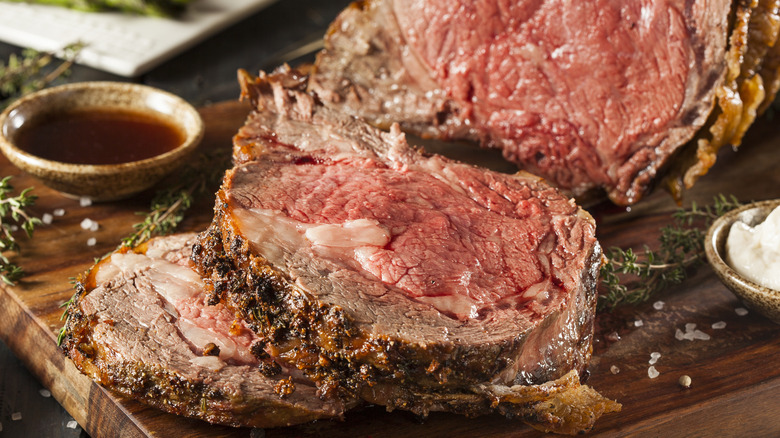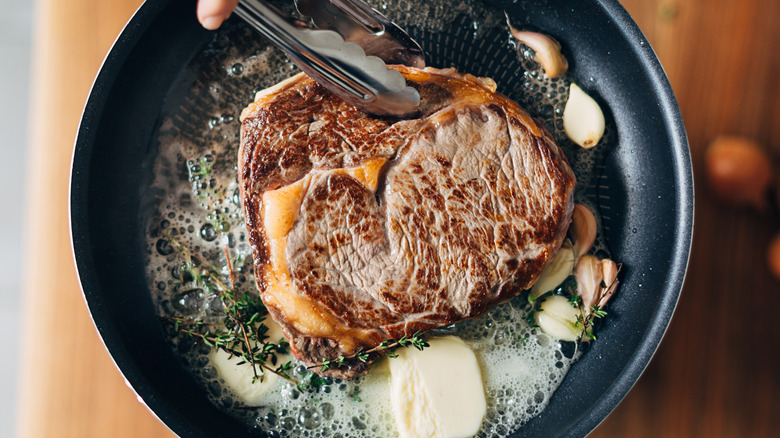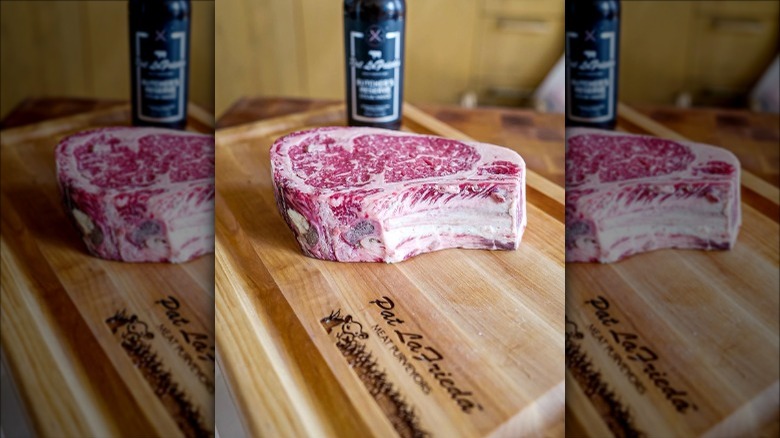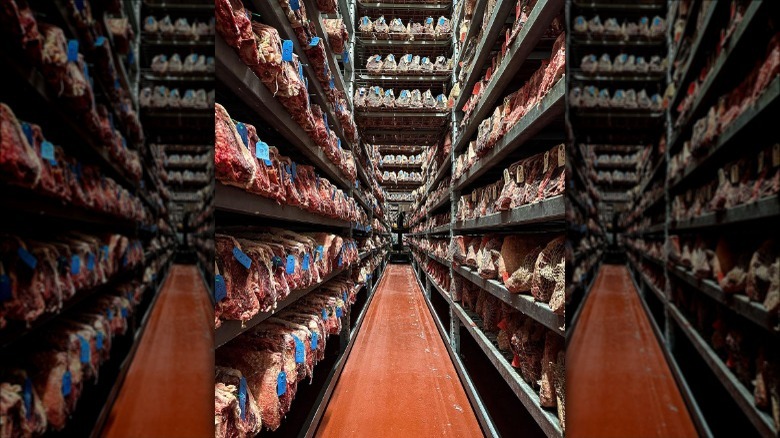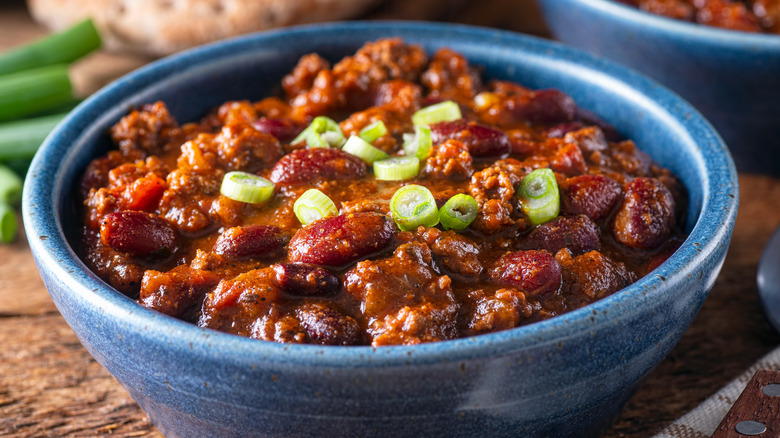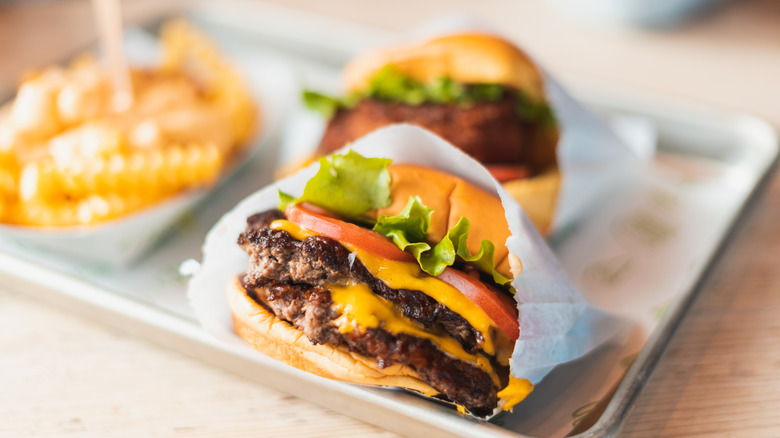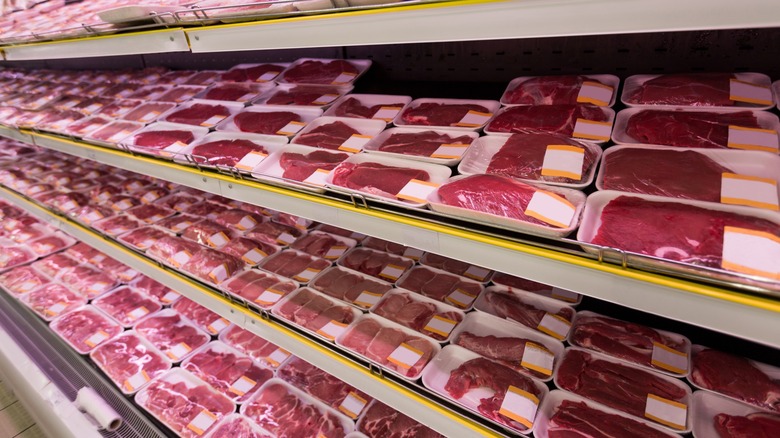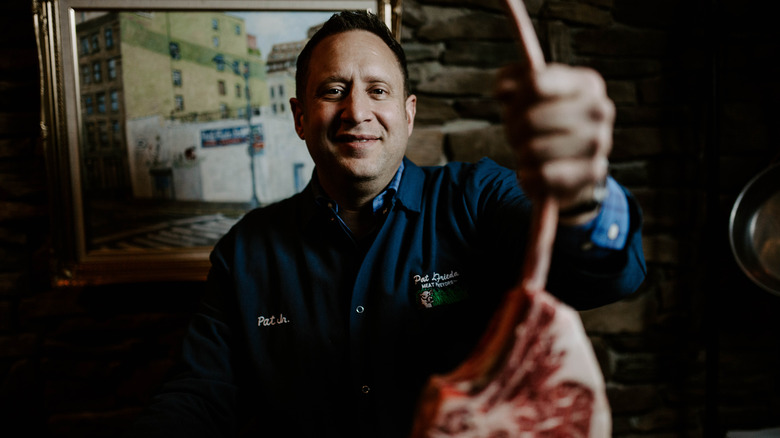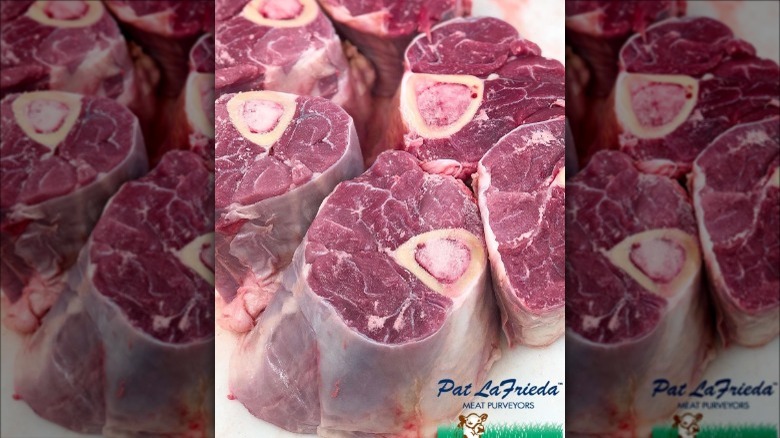How Celebrity Butcher Pat LaFrieda Masters A Tailgate Party And A Perfect Steak Dinner - Exclusive Interview
Super Bowl Sunday is right around the corner, and no matter who you're rooting for, we can at least agree that game day is made for grilling. Whether you're hosting an all-out tailgate party or just chilling in front of the TV, the star of the show is the meat you plan to enjoy while cheering on your team. But if you want to serve up steaks, burgers, and chili that will score big time, then you've got to do it right. We turned to one of the most definitive authorities on the subject for the ultimate beef playbook.
No one knows meat like Pat LaFrieda — the man running the empire that is Pat LaFrieda Meat Purveyors. The fourth-generation New York-based butcher is one of the most celebrated brands in the business, supplying high-quality meat to hundreds of restaurants around the country, including Shake Shack. He's also a cookbook author, Food Network star, and trailblazer of the artisan butcher movement (largely credited for making brand-name meat matter outside of restaurants). LaFrieda and his family have witnessed the evolution of America's meat industry for the last century, all while securing an unmatched reputation, thanks to the flavor and technique that is apparent in every one of their cuts.
The master butcher spoke exclusively with Tasting Table, sharing his plans for Super Bowl Sunday and tips for whatever your game-day menu entails. His expert advice will elevate your beef game whether you're seeking the perfect sear or want to try dry-aging your own meat. He also weighed in on some of the meatiest debates when it comes to beef, including the merits of the grass-fed movement and the controversy surrounding veal.
The perfect game-day prime rib
Do you think you'll be cooking or grilling on Super Bowl Sunday this year?
My house is one where most come for holidays or the Super Bowl, and especially after everything that's gone on in the last couple years, we see things a little differently now. We think we used to cook a lot then, and we cook like it's the last one now.
What are you going to be making?
It's going to be BYOVSE, meaning "bring your own vegetarian something else." It's going to be very meat-centric. We're going to do a prime rib, but we're going to use the prime inside round of beef, and I'm going to cook that to about 120 degrees [Fahrenheit] internal so I can serve each end. Then I can make roast beef sandwiches with rare roast beef all day. Even if you use a prime ribeye, as long as you're cooking it super rare in the center, it makes for the best leftovers, because when you heat them they will not be overcooked. Some leftovers are much better as leftovers, but not meat that's overcooked. When you go to reheat that type of meat and it has a cafeteria lunch gray to it, nobody wants that.
We [inject] the entire roast beef with garlic ... it cooks so well inside. You have real roasted garlic instead of powdered garlic on the outside — it's much more of a truer flavor. When you season a roast, no matter what kind of meat you use, the surface area is very small in comparison to the rest of the whole roast, so when you spear it, you get much more flavor out of each slice than you would any other way.
How are you going to cook it to make sure that you get that perfect rare interior?
I have been doing nothing but reverse searing for the last few years, so I'll roast it at a lower temp — say, 275 degrees. After a roast hits 115 degrees, the speed at which the center rises in temperature is fast. At that point, I'll either put it on the barbecue or I'll broil it on high heat and turn it constantly so that I'm not burning it, but I'm getting the exterior sear.
I've wrestled with this a number of times, and it's easier for me to get a reverse sear because I know that at 115 degrees, if I start that process, I'll be at 125 degrees internal when I have that perfect sear on the exterior. I'm able to pull it at that point and rest it for a good 10 minutes. Then I'll start to take off the strings, but only the strings [where] I'm going to cut. I'm going to leave the strings in the center so it holds its form, especially when it's that rare — otherwise, it could start to fall apart, and you want to keep it firm for that even finish.
Mastering a reverse sear
You've talked about reverse searing a large cut of meat like a prime rib, but are you a fan of this method for smaller cuts of meat as well?
I am. It's about knowing your internal temperatures and watching your times and a constant cooking surface temperature ... The hockey puck surface thermometers are [inexpensive] and it's a gauge that most don't use, but it's important. Putting a surface thermometer on a grill, looking for any cold spots to see if you're preheated — all that information is what professional chefs use.
Usually, 425 to 435 degrees will give you a great sear for a steak, and it doesn't matter what the ambient temperature is in the barbecue. A big mistake most make is closing the barbecue and not letting the moisture escape. That causes a steaming effect to a steak instead of a sear. It's best to leave the top open and use that surface temperature.
A sear is special. It's hard to get the other way because it gets wet. It gets a little steamy as the product cooks, and we're losing moisture when we're cooking meat. As that water escapes, it goes through the same surface as our sear, and it takes that crunch away. It ruins the experience. It may look nice, but when you touch or bite it, it doesn't have that same crunch as a reverse sear. On a reverse sear, you're pulling it out as soon as you've seared it, so it is the perfect steak.
How to make steak like Pat LaFrieda
When you're not cooking for a huge party, what is your favorite steak to make at home?
Skirt steak is my favorite — outside skirt steaks as opposed to inside. [It] sounds very specific, but that's what the Romanian steak always [was] in diners [when I was] growing up. It's my dad's favorite steak; it was my grandfather's favorite steak. It is the one cut of meat that tastes different from everything else. It has those earthy flavors; the only thing that may come close to it is a hanger steak. Where hanger's got more of some liver notes to it, a skirt steak is cleaner than that — it's unique in its flavor.
When it comes to seasoning a steak, do you recommend anything beyond salt and pepper?
Fresh garlic. If we're not spearing any garlic, then we're roasting garlic and butter and pouring it over the steak after. It's a completely different experience.
There's a lot of pepper that goes onto a roast. That pepper will only go on after the process is done. It's almost like fresh rosemary or fresh basil on a pizza. It's got to go on after, because the last thing I want to do is bitter the pepper up with the high heat.
What is the best type of salt to use on a steak, and how do you gauge how much to season without overseasoning?
A crushed coarse salt is best so it keeps that crunch to it. Otherwise, you're just adding salt content. Fresh, hand-cracked salt — as cold as possible — is my favorite.
Dry-aging tips from the master
I saw your dry-aging room on your Instagram. It looks incredible.
We have the largest dry-age room in the world ... It's amazing. We don't have any Himalayan salt in there — we tried that years ago, and it created a science project in which it made the moisture in the air condensate faster. Water can't come out so quickly. Your humidity needs to be between 60 and 70%, but no drier than that. Too dry will lead to sealing up the places where moisture can escape, and if that happens, the meat will rot.
[The key to dry-aging] is the length of time that meat ages under the variables of humidity being controlled and the air circulation being controlled, so as moisture comes to the edges of the protein — because it can't escape through the bone or the fat — air whisks it away. You need circulation for that. The temperature has to be refrigerator temperature, an average of 36 degrees.
The problem is, dehumidifiers don't work in temperatures under 40 degrees, so there are specialized units that take moist air out of the room. They condition it, meaning they dry it, and that air is returned through a separate line into the room in a more dry form. That method is what keeps our humidity controlled.
Should people try to dry-age their steak at home in their fridge?
No, unless you have a fridge you set up just for that. It would be too difficult to control the humidity. Why would you want to? You wouldn't be saving any money.
If it's for craft, then you could set up a fridge in your home, but you'd have to be disciplined not to open the fridge. Refrigerators have drainage lines, so where does that moisture come from? A refrigerator is a natural dehumidifier; that's what it does. The coils get the humidity of the air out, and then it goes to a defrost stage where it's expelling that moisture, it melts it, and that's what the drain line is from. As soon as you open that fridge, whatever the humidity in the room is gets into that small fridge ... and you've blown all the hard work you put into it up to that point.
What is the ideal amount of time that you should be dry-aging beef?
When you first start out, 30 days is a great starting point, but as your palate gets accustomed, you'll want more [dry-aging] as time goes on. If you're doing it at home, you'd probably want to reach that goal of 45 days. You want to hit the point at which you can dry-age and the meat is not rotting, and you have a positive, pleasant smell and aroma of roasted butter and corn.
The secret to a winning game-day chili
Chili is another game-day staple. What do you think is the best meat to use for chili?
Not ground beef. When ground beef is used, it tastes very common. Something called chuck flap tail is what we use. It's [basically] boneless short rib ... it's an extension of that, and it's usually half the price of boneless short rib, but it's the same muscle. We don't grind it. We dice it into small cubes, and that braising effect will turn that into something that's spoon-tender. A fine dice is something any chef at home can accomplish with the right knife, but it takes on a different form when it's ground.
How long do you have to let that simmer to get that spoon-tender texture that you want?
If it's a fine dice, an hour and a half. Try it — it's going to change the way you make chili.
LaFrieda loves a good smashburger
Outside of steaks, Pat LaFrieda Purveyors supplies beef for a lot of good restaurant burgers. What is your favorite Pat LaFrieda burger?
My Shake Shack intake is huge, and it's something that my kids also love, so we have a lot of Shake Shack meals here. I had a burger at Citi Field yesterday at Chop House [with] urbani truffle in it. It's simply amazing. Industry Restaurant, which is out in Sparta, New Jersey ... [It's] fascinating how much thought they're putting into a burger.
I love seeing food passion and how it has spread throughout all parts of our country. It's amazing.
What are the most important things we should keep in mind when making burgers at home?
We don't use any trimmings when we make our burgers. Our burgers are made from whole cuts of meat. That's important because there's no other way to control the flavor of it ... Specific cuts of meat that are made for burgers is what's important, because then you'll have that same burger experience time after time. If it's trimmings or there are no claims on it, then it could be meat from anywhere.
I support American growers and farmers, and we have 125 different growers we work with from around the country. We'll only use meat that's raised and grazed in the United States, and there's a lot of product in the U.S. that won't make a country of origin claim, because they don't have to if it's not from the U.S.
What's the best way to make a burger, on the grill or smashing it in a pan?
I don't think smashing is necessary, [but] if you want to smash, the important part is to make sure the cast iron that you're smashing it on is hot. You definitely want that thermometer, and you want that to be 425-plus degrees, because if you smash a burger on that and you're not getting a sear immediately and you're not able to flip it within a minute, it's going to stick.
The other way to do that is you could buy four-ounce burgers in flat form so they're about five inches in diameter, so they're really wide and thin, and you're able to put them down onto a cast iron and not mess with them. You can let them cook and not have to be as concerned about the surface temperature because you'll know when it's time to flip that burger, and you don't have to smash it.
[A smashburger] also limits you to a cast iron skillet as opposed to a barbecue. A barbecue offers great textures and flavors that a cast iron can't always offer.
You can get great meat at the grocery store
I'd expect you to say that when it comes to buying meat and buying steak, we should get it from a butcher. Regardless of where we're getting our steak, what are the signs of high-quality versus low-quality meat that we should be looking for?
I wouldn't say you have to get it from the butcher. Buying meat from a store is just as good. I would immediately look for a USDA establishment number, so look for that circle that's got "EST" written in it with a five- or six-digit number — ours is 4651. The reason why I say to look for that is I'm big into food safety, and our facility is run under USDA oversight. We have meat inspectors in both facilities every day throughout production. Where restaurants get the Health Department to come once or twice a year, we have the USDA every day, so there are no claims on our products that haven't been verified by the USDA.
It's rare to hear of foodborne illness from meat from a restaurant. That's because any butcher who sells meat to restaurants has to be USDA inspected, whereas butcher shops don't need to be. If they only sell to retail, they don't need to be. The public doesn't understand that as much. Supermarkets will mostly buy their products from USDA facilities, and you can be assured that meat is safe.
Also, the claims "all-natural, organic, grass-fed" — forget about what they mean; that's a different subject. If the claim is on there and it's from a USDA facility, USDA has gone to great lengths to verify that. We could debate about whether that's better for the environment or not, better for humans than not, better for the animals or not, but people are set in what they believe. To say grass-fed is better ... I think [that's] a belief that's coming to an end.
The grass isn't always greener with grass-fed beef
Setting aside the environmental or health concerns and that debate, do you think grass-fed beef tastes better?
No, and it's not better for the environment, for the simple reason that it takes two to three times longer for that animal to get to the right size to harvest. When you're looking at a steer that's about 750 to 850 pounds hanging weight, if it's purely grass-fed, then it most likely will have gone over 30 months of age. [That] has a whole bunch of other issues, especially with this new green idea of too many animals on Earth causing a problem and a huge carbon footprint ... Grass-fed's got to live past 30 months of age, whereas most beef has had 22 months of age.
That's a debate that's been going on within the green movement that I've been paying close attention to, because for years, we all thought that maybe that had less impact on the environment. But it turns out that all beef is fed grass — it's what it is finished on. Finishing it on corn, especially when the corn is derived from the neighbor, the grower — that's local, that's sustainable, and the carbon footprint that's recorded in those circumstances is low. As a meat purveyor, it's my job to stay on top of the evidence [and] to be able to provide that information to my consumers for them to make the choice.
There's a lot of misconceptions because of great marketing. It's been great marketing in that it worked, but it may not exactly have been accurate.
How the meat industry has evolved
Your family business recently celebrated its 100th anniversary. What do you think has changed the most about this business, and where do you see the next trends taking us?
What I've seen change the most is the efficiency. When my dad was younger, when he worked with his father, he would have to bring in a side of beef and sell the entire side of beef, whereas now, we're not doing that. We're bringing in the parts that we use the most. That's important because we always want meat to be affordable and accessible to everyone, so the more efficient the industry is, the more affordable the product will be.
I think that sense of efficiency will continue, and what we've seen most is beef being celebrated. That's something that's traditional, like beef steak nights, and that was always a time for a celebration. We're very pro-plant-based proteins and any other source of protein that's possible, but still, when it's a special event, beef is what's celebrated. Unfortunately, we see a lot less veal being used [because of] the misconceptions of veal, but that ship has sailed already. When I started, veal was more celebrated than beef.
We've got it all wrong when it comes to veal
A lot of people think veal is just baby cow and don't want to eat that. What is the big misconception here?
Veal is not baby beef. There is veal that is derived from baby beef — that's what the chain restaurants use, but what restaurants in New York City use that I grew up cutting was something coveted.
The steaks that we eat are 22 months of age. Veal is 10 months. Is that a baby, when an adult is 22 months? Not really. Baby veal is veal that's just born and harvested, and that's what you find in chain Italian restaurants ... It's called Bob veal. They don't have to be chained down, but they're definitely confined.
These cattle that I'm talking about — usually Holsteins — they're the males for the milking industry that obviously are not going to yield milk. What would you do with those, then? Holsteins are not good for making steaks ... It was a sustainable way for the milk industry to continue and [provide] a great product.
There were some growers [who] would restrain the movement of the veal because the more movement, the more iron, and the [redder] it would get. Over the last 60 years, they've found great ways to not have to do that and grow the same quality veal. But it's a hard story to tell for anyone to understand that this inhumane way of treating animals has been corrected, and the finished product is like it used to be. What we were all worried or horrified about has been corrected, and veal is just an amazing byproduct of the milking industry.
We don't use Bob veal in any capacity, and no one's even asked me for that in the last 20 years. That's the difference.
Click here to learn more about Pat LaFrieda Meat Purveyors and their wholesale options for quality cuts of meat.
This interview has been edited for length and clarity.
